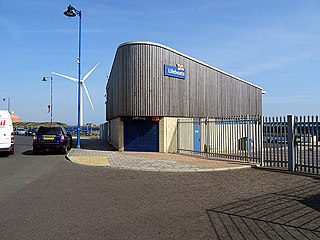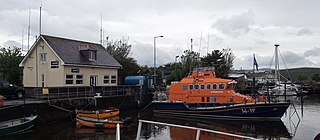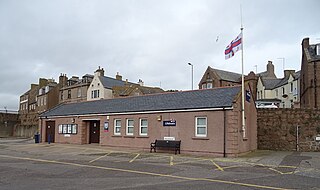History
On 10 November 1831, a coastguard officer and 10 men launched the local private lifeboat, to the aid of the brig Lady Montgomerie, which sank off Saltcoats harbour. The Master, Mate and one crew man were lost, but two apprentices were rescued. Ever since its founding in 1824, the Royal National Institution for the Preservation of Life from Shipwreck (RNIPLS), later to become the RNLI in 1854, would award medals for deeds of gallantry at sea, even if no lifeboats were involved. Lt. William Lyons, RN, H.M. Coastguard, was awarded the RNIPLS Silver Medal. [3]
Following the report from the Inspector of Lifeboats, and with the kind co-operation of G. B. M. Beatson, late Divisional Officer of H.M. Coastguard, at the meeting of the RNLI committee of management on 4 Nov 1869, it was decided to takeover the existing Ardrossan lifeboat station. As the existing boat was an old obsolete version, a new lifeboat with carriage were provided, and a new boathouse was constructed. [4] [5]
The lifeboat and carriage were conveyed free of charge from Carlisle to Ardrossan by the Glasgow and South Western Railway Company. On the 18th June 1870, the lifeboat was taken in a grand procession through the town to the outer harbour, with vessels, houses and public buildings decorated with flags, and joined by members of the lifeboat committee, Town Council, local artillery volunteers, freemasons, and two bands. The lifeboat was then launched and demonstrator to the watching crowd. [5] [6]
The entire cost of the station, lifeboat, carriage and equipment was met by the gift of Mr. Peter Reid of London. At his request, the lifeboat was named Fair Maid of Perth. Mr Reid had previously funded the lifeboat Palmerston, stationed at Cullercoats. [5]
Just 6 months later, the lifeboat would be called for the first time. On New Years Day 1871, the lifeboat launched at 10:00 to the brig Morning Star of Dublin, driven ashore on the west side of Horse Isle, in a S.S.W. gale. The lifeboat was towed to the vessel by Steam tug, finding the crew clinging to a rock, but unable to get ashore. With the help of a line, 5 men were pulled through the surf to the lifeboat, although the last man managed to swim to the island, and was picked up. All six were landed at Ardrossan. [7] [8] [9]
The Fair Maid of Perth was launched to the barque Matilda Hilyard on 1 March 1880. After the rescue of her 12 crew, the lifeboat was being towed to harbour by a steam tug, when the lifeboat capsized. Two lifeboat crew, William Grier and Alexander McEwan, were lost, along with two crew members of the Matilda Hilyard, John Hickey (United States) and Vincent Luthemburger (Austria). Coxswain William Breckenridge died later of congestion of the lungs. There is no mention of the capsize and loss of life in the minutes of the RNLI committee of management of 1 April 1880. It was recorded that a replacement lifeboat was being sent to Ardrossan, and that 10 lives were recorded saved from the Matilda Hilyard. [10] [11]
In the RNLI journal 'The Lifeboat' of 1 November 1881, it was recorded of Ardrossan, that "The National Life-boat Institution has provided a new Life-boat for this place, the crew having lost confidence in the old boat, consequent on her having upset when in tow. The new lifeboat was 34-foot long, and after trials, it was reported that the crew was very happy with the new boat, with its better steering and easier rowing. Funded once again by Mr Peter Reid, the lifeboat was again named Fair Maid of Perth. [12]
At a meeting of the RNLI committee of management on Thursday 10 April 1930, it was decided that Ardrossan would be one of four lifeboat stations to be closed, the others being Hope Cove, Looe and Mevagissey. [13]
The Ardrossan boathouse was built on the lighthouse (west) pier in the harbour. Now a busy terminal, nothing remains of the building. The lifeboat on station at the time of closure, James and John Young (ON 636), was first transferred to the relief fleet, and sold out of service in 1939. [2]






















